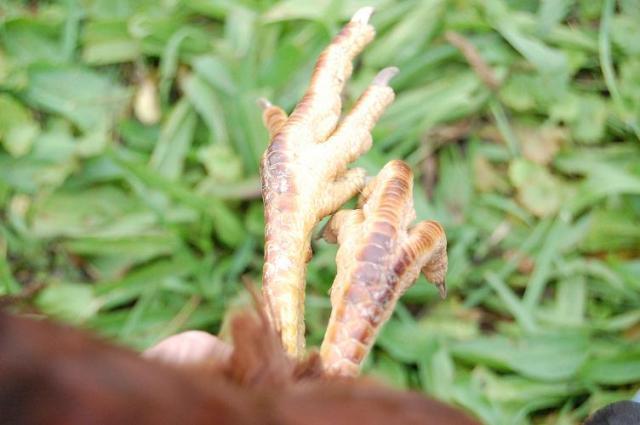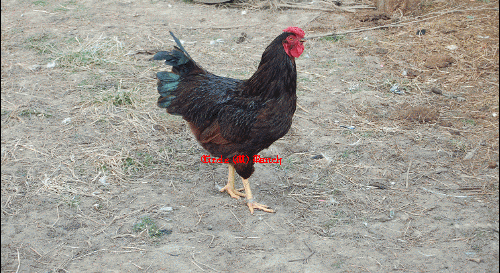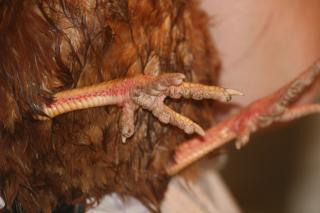I love everything about that bird but the leg color. I think I have found my new pet peeve.. you know.. the one no one else cares about but I get all finiky about.. ya.. that one LOL.. Other wise I love that hen. She looks different from mine however.. may I ask what strain she is. Im just learning so I like to learn what each strain looks like.
Navigation
Install the app
How to install the app on iOS
Follow along with the video below to see how to install our site as a web app on your home screen.
Note: This feature may not be available in some browsers.
More options
You are using an out of date browser. It may not display this or other websites correctly.
You should upgrade or use an alternative browser.
You should upgrade or use an alternative browser.
The Heritage Rhode Island Red Site
- Thread starter Robert Blosl
- Start date
Quote:
Actually, the picture with the leg color is from a different bird. The legs are brighter yellow than that picture, with the "reddish horn" on them. This is accurate, according to the SOP.
"Rich yellow tinged with reddish horn. A line of red pigment down the sides of shanks extending to tips of toes, is desirable."
My rosecomb RIRs came from Dick Horstman, but I have only straight comb roosters.
Actually, the picture with the leg color is from a different bird. The legs are brighter yellow than that picture, with the "reddish horn" on them. This is accurate, according to the SOP.
"Rich yellow tinged with reddish horn. A line of red pigment down the sides of shanks extending to tips of toes, is desirable."
My rosecomb RIRs came from Dick Horstman, but I have only straight comb roosters.
Last edited:
In the photo the red shading looked great, but the leg did look shell color, not a bright yellow. I know cameras can be deceptive however if you compare the yellow in the photos I posted its a difference. Don't mind me though. I always have these strange little pet peves in anything I breed. With my horses I actually have their cannon bones and lumbar ultra sounded. Something in the old days they had to check after death. My puristic ways will get on your last nerve one day. Best to just shake your head and laugh thats what my family does. Its not that Im putting other traits down, it is that Im looking for certain things I don't want to loose. Some how it doesn't come out right all the time, so.. in short.. Nice bird.. however I would like her better with bright yellow legs.
LOL ..... If it is only leg color ..... feed her some corn = YELLOW ! !

By the way ..... I do NOT feed corn.

By the way ..... I do NOT feed corn.
Last edited:
Quote:
I would be willing to bet that the flash, "washed" out the color of the legs on Kathy's bird. I have seen pictures of her birds and they have good color.
The thing that you have to remember is that "Pet Peeves" can get you in trouble when breeding poultry and you have to build a barn before you paint it.
For example with the flash, "washing out" the color of the legs.
Theses Legs are Yellow when looking at them in person --

And on this bird --

Chris
I would be willing to bet that the flash, "washed" out the color of the legs on Kathy's bird. I have seen pictures of her birds and they have good color.
The thing that you have to remember is that "Pet Peeves" can get you in trouble when breeding poultry and you have to build a barn before you paint it.
For example with the flash, "washing out" the color of the legs.
Theses Legs are Yellow when looking at them in person --

And on this bird --

Chris
Last edited:
Its got allot more red then this 4mth old baby has and I like that! I don't want to loose that red either. I do think that one trait is connected to the other and if you loose one thing, you may loose something else you weren't planning on. genetics are genetics, it doesn't' matter if its birds, cows or people when you have a trait, its always connected to something else, the question is what else.
Here is what I mean by yellow..

Uploaded with ImageShack.us
The feet are from a cockrel and the hen is the same age. They are both from the same clutch. You can see the red on her legs and you can see they are very much different from the bird in the photo posted with the lighter legs.

Uploaded with ImageShack.us
Here is what I mean by yellow..

Uploaded with ImageShack.us
The feet are from a cockrel and the hen is the same age. They are both from the same clutch. You can see the red on her legs and you can see they are very much different from the bird in the photo posted with the lighter legs.

Uploaded with ImageShack.us
Last edited:
- Jan 14, 2008
- 5,644
- 497
- 303
Even if the legs were as light as they appear in the picture, & I'm sure they're not, It's not a disqualification & in fact it's not even a stated point cut. If you were judging 2 birds that were exactly the same except for the leg colour it might become a deciding point. That said, it's not at all uncommon for yellow legged females, in production, to lose leg colour & in judging hens it's not even a consideration in most cases.
Feeding corn doesn't influence leg colour as much as you might think. I do feed corn & my R I Red & other yellow legged females still lose leg colour when they're laying heavily. The colour usually returns after a molt.
If you're serious about producing quality birds it's foolish to get hung up on any single minor point. You have to learn to evaluate the bird as a whole. The breed is Rhode Island Red, not Yellow Leg.
Feeding corn doesn't influence leg colour as much as you might think. I do feed corn & my R I Red & other yellow legged females still lose leg colour when they're laying heavily. The colour usually returns after a molt.
If you're serious about producing quality birds it's foolish to get hung up on any single minor point. You have to learn to evaluate the bird as a whole. The breed is Rhode Island Red, not Yellow Leg.
Last edited:
I agree that breeding for leg color alone is redundant. The over all bird is what we are all after. I will also say that one trait is connected to the next. Like the black pin feathers, or the dark beak, its all relevant in connecting the dots to make the whole bird. for example, you would not have a perfect bird except it would have a light eye. The reason is the gene that makes that red eye, also makes something else, its connected, there for the bird with the light eye would also have something else wrong. sometimes its the details that count. I do agree that some things are minute and can be over looked for a short while, however in creating perfection, sooner or later, you have to look at the whole.
Gosh I wish the red stripe had been posted 3 weeks ago. I just found this link on Monday:
" the standard calls out a red stripe on the leg. (http://bloslspoutlryfarm.tripod.com/id55.html)
Legs and toes: Lower thighs rich, dark red. Shanks and toes rich yellow tinged with reddish horn. A line of red pigment down the sides of shanks, extending to tips of toes, is desirable."
I may have even e-mailed Bob to ask the question?
Why do my RIR legs have a red stripe down the leg? She has been favoring her right leg and after finding nothing about the red stripe, I treated her for mites and then a week later bumblefoot. She is spoiled rotten now from all the yogurt! I emailed some members of the RIR club and two responded that I was not to worry, it was normal.
I bought her from Rural King for $1.97, who would have known she would be "true" enough to have the red stripe. So for the novice, red stripes are ok, not to worry.

Thanks Bob for the article and thanks RIR club for answering my question.
" the standard calls out a red stripe on the leg. (http://bloslspoutlryfarm.tripod.com/id55.html)
Legs and toes: Lower thighs rich, dark red. Shanks and toes rich yellow tinged with reddish horn. A line of red pigment down the sides of shanks, extending to tips of toes, is desirable."
I may have even e-mailed Bob to ask the question?
Why do my RIR legs have a red stripe down the leg? She has been favoring her right leg and after finding nothing about the red stripe, I treated her for mites and then a week later bumblefoot. She is spoiled rotten now from all the yogurt! I emailed some members of the RIR club and two responded that I was not to worry, it was normal.
I bought her from Rural King for $1.97, who would have known she would be "true" enough to have the red stripe. So for the novice, red stripes are ok, not to worry.

Thanks Bob for the article and thanks RIR club for answering my question.
- Jan 14, 2008
- 5,644
- 497
- 303
Quote:
This illustrates the point about being hung up on a minor consideration. The pullet pictured does have a bright yellow leg. She also has too much black in her hackle. an obvious cushion that she shouldn't have, a pinched tail & she isn't as full in the chest as she needs to be. All much more serious considerations than a slightly pale leg.
This illustrates the point about being hung up on a minor consideration. The pullet pictured does have a bright yellow leg. She also has too much black in her hackle. an obvious cushion that she shouldn't have, a pinched tail & she isn't as full in the chest as she needs to be. All much more serious considerations than a slightly pale leg.
New posts New threads Active threads
-
Latest threads
-
What type of feed do you feed your chickens/ducks
- Started by thelordsblessing2017
- Replies: 0
-
Tips for temporary coop for integration
- Started by Sarynda
- Replies: 0
-
-
losing feathers, has dry skin, dry nub whats happening?
- Started by JackAyla
- Replies: 2
-
-
-
Threads with more replies in the last 15 days
-
-
-
-
How intense is your pecking order?
- Started by thecatumbrella
- Replies: 96
-
I know I’m probably going to upset some ppl, but I’m genuinely confused..
- Started by z3lda3
- Replies: 91
-
×


